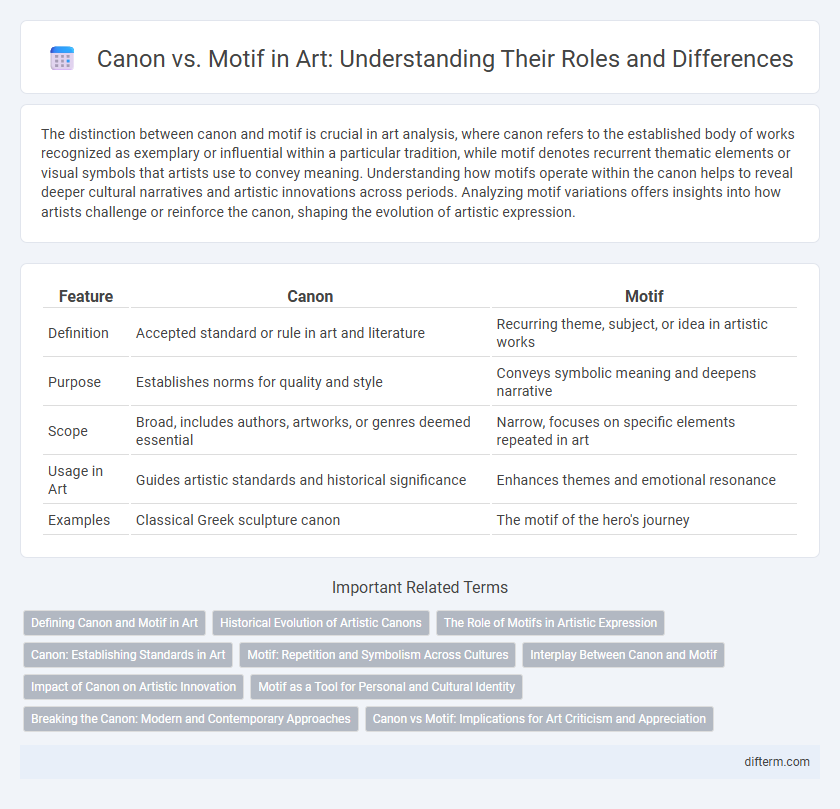The distinction between canon and motif is crucial in art analysis, where canon refers to the established body of works recognized as exemplary or influential within a particular tradition, while motif denotes recurrent thematic elements or visual symbols that artists use to convey meaning. Understanding how motifs operate within the canon helps to reveal deeper cultural narratives and artistic innovations across periods. Analyzing motif variations offers insights into how artists challenge or reinforce the canon, shaping the evolution of artistic expression.
Table of Comparison
| Feature | Canon | Motif |
|---|---|---|
| Definition | Accepted standard or rule in art and literature | Recurring theme, subject, or idea in artistic works |
| Purpose | Establishes norms for quality and style | Conveys symbolic meaning and deepens narrative |
| Scope | Broad, includes authors, artworks, or genres deemed essential | Narrow, focuses on specific elements repeated in art |
| Usage in Art | Guides artistic standards and historical significance | Enhances themes and emotional resonance |
| Examples | Classical Greek sculpture canon | The motif of the hero's journey |
Defining Canon and Motif in Art
Canon in art refers to a set of established principles or rules that define what is considered classic or exemplary within a particular style or period, often guiding the creation and evaluation of artworks. Motif, on the other hand, is a recurring thematic element, symbol, or pattern used by artists to convey specific ideas or emotions across different pieces. Understanding the distinction between canon and motif allows deeper insight into how art history is structured and how artists communicate visually through consistent symbolic language.
Historical Evolution of Artistic Canons
Artistic canons have historically evolved as collections of works considered exemplary within specific cultures, often reflecting dominant aesthetic values and social hierarchies. Motifs, by contrast, are recurring thematic or visual elements that transcend individual artworks and styles, serving as building blocks for artistic expression across periods. The tension between canon formation and motif recurrence highlights shifting cultural priorities, as marginalized artists and alternative motifs challenge established norms and diversify the art historical narrative.
The Role of Motifs in Artistic Expression
Motifs serve as recurring visual elements that enrich a work's thematic depth and facilitate symbolic communication, contrasting with a canon that dictates established artistic norms and styles. The use of motifs enables artists to convey cultural narratives, emotional undertones, and abstract concepts through repeated imagery or patterns. This dynamic repetition fosters viewers' recognition and emotional resonance, enhancing the expressive power and interpretive layers within artwork.
Canon: Establishing Standards in Art
Canon in art refers to the established standards and principles that define the most influential works, styles, and artists considered exemplary across history and culture. It serves as a benchmark for quality, artistic merit, and cultural significance, guiding both academic study and artistic practice. The canon shapes aesthetic values, influencing which artworks are preserved, exhibited, and taught in institutions worldwide.
Motif: Repetition and Symbolism Across Cultures
Motif in art refers to recurring elements or themes that carry symbolic meaning, often repeated to create visual rhythm and reinforce cultural narratives. These motifs vary across cultures, embodying values, beliefs, and traditions unique to each society, such as the lotus in Asian art symbolizing purity or the spiral in Celtic designs representing growth and continuity. Repetition of motifs amplifies their significance, allowing artists to communicate complex ideas and create a cohesive aesthetic experience rooted in shared symbolism.
Interplay Between Canon and Motif
The interplay between canon and motif in art reveals how established canonical works influence recurring thematic elements across various styles and periods. Canon provides a framework of celebrated masterpieces that shape artistic standards, while motifs offer adaptable visual or conceptual symbols that artists reinterpret for innovation and cultural commentary. This dynamic relationship fuels creativity, allowing motifs to evolve within the boundaries set by canon, enriching art history with both tradition and transformation.
Impact of Canon on Artistic Innovation
The canon in art establishes a recognized framework that shapes artistic standards and influences creators' techniques and themes, often guiding the evolution of new styles within accepted boundaries. This structured foundation can both inspire innovative reinterpretations of traditional forms and inadvertently limit experimentation by prioritizing established norms. Understanding the tension between adherence to the canon and the emergence of original motifs reveals the complex dynamic driving artistic innovation and cultural progression.
Motif as a Tool for Personal and Cultural Identity
Motifs serve as powerful tools for expressing personal and cultural identity by encapsulating shared symbols and themes that resonate across generations. They provide artists with a visual language to communicate heritage, beliefs, and experiences, bridging individual creativity with collective memory. Through repeated patterns or imagery, motifs reinforce cultural narratives and foster a sense of belonging within diverse art contexts.
Breaking the Canon: Modern and Contemporary Approaches
Breaking the canon in modern and contemporary art involves challenging traditional motifs and established aesthetic rules that have long dominated artistic expression. Artists experiment with diverse media, cultural narratives, and unconventional techniques to subvert classical themes and reinvent visual language. This dynamic approach redefines art history and opens dialogue on inclusivity and originality beyond canonical boundaries.
Canon vs Motif: Implications for Art Criticism and Appreciation
Canon in art refers to a set of established works or artists deemed representative and authoritative within a cultural or historical context, shaping standards of artistic excellence. Motif involves recurring thematic elements, symbols, or patterns that convey specific meanings or emotions across various artworks and styles. Understanding the distinction between canon and motif allows art critics to evaluate cultural significance and interpret symbolism, enriching appreciation through nuanced analysis of both recognized masterpieces and thematic influences.
canon vs motif Infographic

 difterm.com
difterm.com